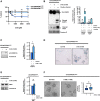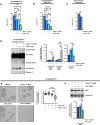Compensatory cross-talk between autophagy and glycolysis regulates senescence and stemness in heterogeneous glioblastoma tumor subpopulations
- PMID: 37420311
- PMCID: PMC10327182
- DOI: 10.1186/s40478-023-01604-y
Compensatory cross-talk between autophagy and glycolysis regulates senescence and stemness in heterogeneous glioblastoma tumor subpopulations
Abstract
Despite tremendous research efforts, successful targeting of aberrant tumor metabolism in clinical practice has remained elusive. Tumor heterogeneity and plasticity may play a role in the clinical failure of metabolism-targeting interventions for treating cancer patients. Moreover, compensatory growth-related processes and adaptive responses exhibited by heterogeneous tumor subpopulations to metabolic inhibitors are poorly understood. Here, by using clinically-relevant patient-derived glioblastoma (GBM) cell models, we explore the cross-talk between glycolysis, autophagy, and senescence in maintaining tumor stemness. We found that stem cell-like GBM tumor subpopulations possessed higher basal levels of glycolytic activity and increased expression of several glycolysis-related enzymes including, GLUT1/SLC2A1, PFKP, ALDOA, GAPDH, ENO1, PKM2, and LDH, compared to their non-stem-like counterparts. Importantly, bioinformatics analysis also revealed that the mRNA expression of glycolytic enzymes positively correlates with stemness markers (CD133/PROM1 and SOX2) in patient GBM tumors. While treatment with glycolysis inhibitors induced senescence in stem cell-like GBM tumor subpopulations, as evidenced by increased β-galactosidase staining and upregulation of the cell cycle regulators p21Waf1/Cip1/CDKN1A and p16INK4A/CDKN2A, these cells maintained their aggressive stemness features and failed to undergo apoptotic cell death. Using various techniques including autophagy flux and EGFP-MAP1LC3B+ puncta formation analysis, we determined that inhibition of glycolysis led to the induction of autophagy in stem cell-like GBM tumor subpopulations, but not in their non-stem-like counterparts. Similarly, blocking autophagy in stem cell-like GBM tumor subpopulations induced senescence-associated growth arrest without hampering stemness capacity or inducing apoptosis while reciprocally upregulating glycolytic activity. Combinatorial treatment of stem cell-like GBM tumor subpopulations with autophagy and glycolysis inhibitors blocked the induction of senescence while drastically impairing their stemness capacity which drove cells towards apoptotic cell death. These findings identify a novel and complex compensatory interplay between glycolysis, autophagy, and senescence that helps maintain stemness in heterogeneous GBM tumor subpopulations and provides a survival advantage during metabolic stress.
Keywords: Autophagy; Cancer stem cell-like cells; Glioblastoma; Glycolysis; Metabolism; Senescence; Tumor heterogeneity.
© 2023. Crown.
Conflict of interest statement
The authors declare that they have no competing interests.
Figures







References
-
- Andrzejewski S, Klimcakova E, Johnson RM, Tabaries S, Annis MG, McGuirk S, Northey JJ, Chenard V, Sriram U, Papadopoli DJ, et al. PGC-1alpha promotes breast cancer metastasis and confers bioenergetic flexibility against metabolic drugs. Cell Metab. 2017;26:778–787. doi: 10.1016/j.cmet.2017.09.006. - DOI - PubMed
Publication types
MeSH terms
Substances
LinkOut - more resources
Full Text Sources
Medical
Research Materials
Miscellaneous

